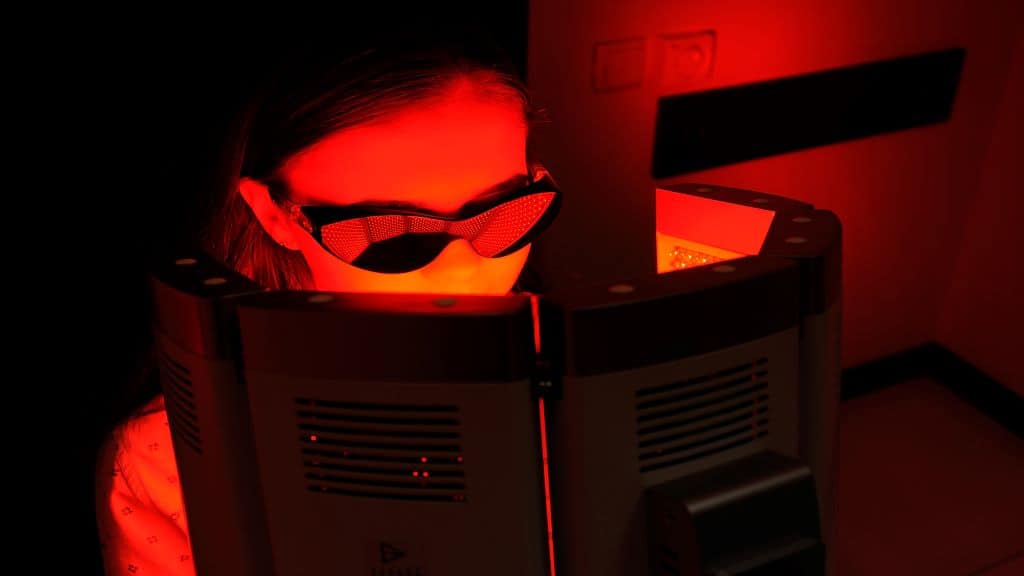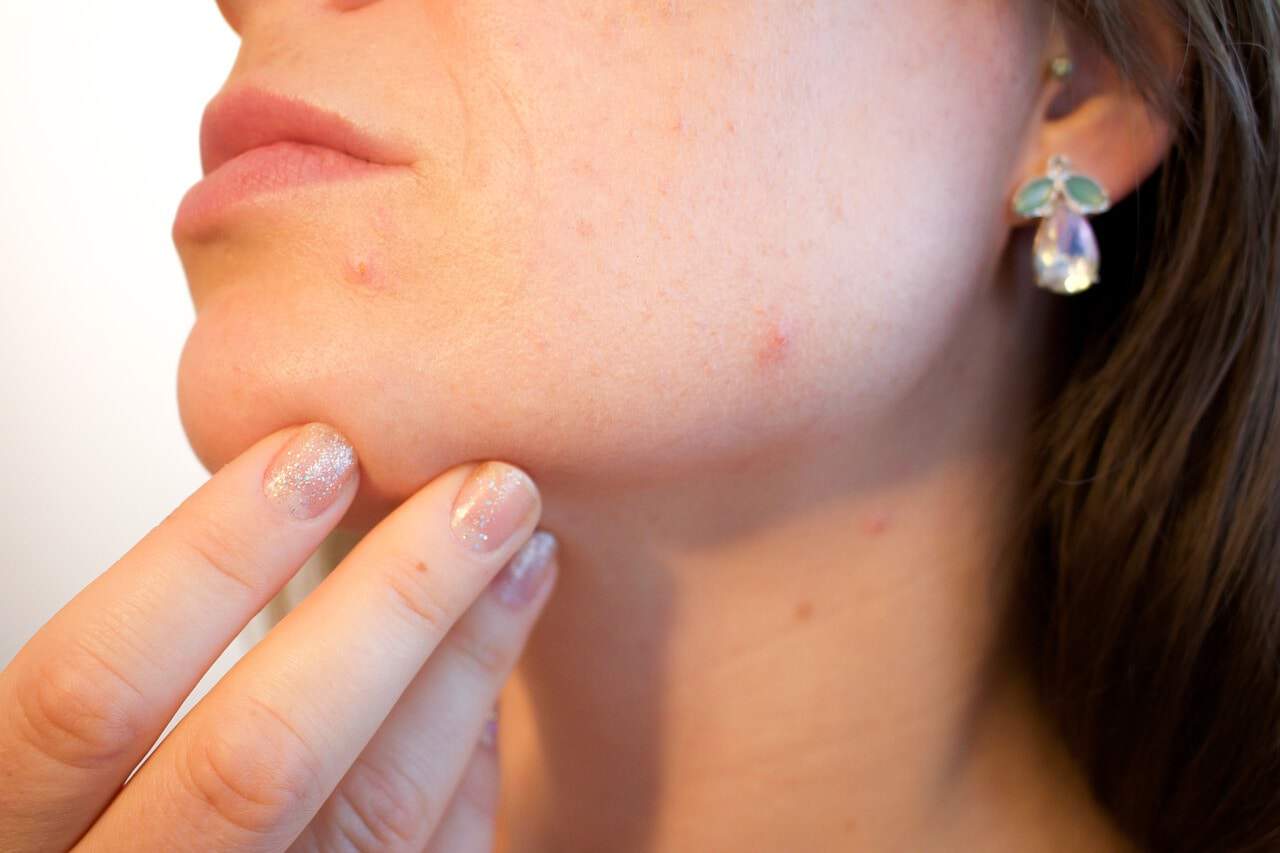Scientists and doctors have found that LED light therapy can significantly aid in reducing acne and wrinkles using varying wavelengths of light.
LED stands for light-emitting diode therapy and uses primarily red and blue light for anti-aging and acne treatments. NASA developed it originally for plant growth experiments on shuttle missions and later discovered that it could help treat wounds.
Some aestheticians use light therapy to help regenerate skin and prevent aging, and healthcare providers often use it for treating acne. Red light helps with wrinkles and other age-related skin issues, and blue light aids with acne treatment. Luckily, LEDs don’t have UV rays, unlike different types of light therapy, so you don’t have to worry about getting cancer. LED light therapy also doesn’t cause burns compared to other kinds of skin treatments such as dermabrasion, chemical peels, and laser therapy.
However, you should not use light therapy if you take prescription medicines for acne or have skin rashes. While side effects don’t usually happen, some people experience inflammation, redness, and rashes from treatment. Now that you know a little about the procedure, let’s get into how exactly it helps reduce acne and wrinkles.
Here’s how LED light therapy can reduce acne and wrinkles:
First, let’s examine the science behind this breakthrough in the skincare industry.
What is LED light therapy?
A light-emitting diode (LED) light therapy can be given both in an office setting or at home. Using varying LED wavelengths, this relatively new skincare technology can help:
- treat acne
- reduce inflammation
- decrease wrinkles and other signs of aging
You may want to check out this skincare technique if you’ve tried over-the-counter creams and medicines and still haven’t seen the results you want. All skin colors do well with LED therapy, and it doesn’t cause any burns like other types of skin care treatments.
However, keep in mind that this treatment does have disadvantages. Here are a few:
- LED therapy can be expensive.
- The results aren’t guaranteed.
- You can’t qualify for it if you take certain medications or have an existing skin disorder.
If this interests you, talk to your dermatologist to see if you’d be a good candidate for the treatment.
How much does it cost?
Unfortunately, insurance doesn’t cover LED skin treatment Costs vary from clinic to clinic, but usually, a single session can range from $25 to $85, according to patients who reported costs on realself.com. It also depends on where you live and if you have any additional treatments. Most aestheticians recommend up to 10 sessions, so make sure to take the total cost into account as you visit with different practitioners to make a decision.
If you choose to do home treatments, they can range anywhere from $25 to $250 or more. Overall, this might save you money in the long run because you can keep the device and use it for more treatments in the future if you wish. However, don’t expect to get the same results as in an office setting. Either way, LED light therapy does not take long and is noninvasive, so you don’t have to worry about side effects.
Here’s how LED light therapy works
LED light therapy helps with a wide variety of conditions. The U.S. Navy SEALs starting using it in the 1990s to help regenerate damaged muscle tissues and heal wounds faster. Since then, aestheticians have made use of it to treat various skin conditions. Mainly, LED light therapy helps to increase tissues and collagen, which can smooth out skin and reduce aging from age spots, acne, and wrinkles.
LED light therapy works on different frequencies or ranges of light. These include blue and red light wavelengths, which don’t have UV rays and get absorbed into the skin fairly quickly.
Red light
Red, or infrared light, treats the epidermis or the outer layer of the skin. When the light gets applied to your skin, the epidermis absorbs it, which then stimulates the production of collagen. More collagen means that your skin will appear more smooth and full, which will reduce wrinkles and lines on the skin’s surface. Red LED light also helps reduce inflammation and improve circulation, which also makes the skin look healthier.
Blue light
Blue LED light therapy targets the sebaceous glands or oil glands. These are located just beneath the hair follicles. Sebaceous glands help lubricate the skin and hair, so they don’t dry out. However, these glands can become overactive, which leads to oily skin and acne. Blue LED light therapy can target these glands and decrease their activity. This will help reduce the occurrence of acne breakouts.
Blue light can also kill bacteria under the skin that causes acne, which helps treat severe acne pimples, including cysts and nodules. Sometimes, a blue LED light can be used along with red LED light to treat acne, reduce scarring, and lower inflammation. One animal study from 2018 found that blue LED light helped improve the healing of third-degree burns on the skin.
The procedure
According to EstheticianEDU, each treatment will last about 20 minutes. You’ll need up to 10 treatments total in some cases, depending on what results you want. Some clinics will have you lie down directly under the lights while others use light-infused wands directly over the skin. If you choose to do it at home, you can use masks or wands that you’ll apply to your face for several minutes at a time.
LED light therapy can work on any part of the body, but most people use it for the face. Skin damage occurs more frequently on the face because it gets more exposure than other body parts. Some treatments include light therapy on the neck and chest, which often show signs of aging more quickly than others.
Risks and side effects of LED light therapy
Studies by the American Academy of Dermatology have shown LED light therapy to be safe and effective for the treatment of acne and other skin conditions. Because it doesn’t contain UV rays, poses few risks, and doesn’t involve surgery, light therapy will not cause long-term damage.
If you require light therapy, your provider may recommend LED, especially if you have sensitive or darker skin. LEDs won’t burn your skin like more invasive and harsh therapies such as laser, and they won’t cause pain. However, LED therapy still comes with risks that you should consider before getting treatment. If you take Accutane for acne, the light may enhance scarring because of the high concentration of Vitamin A in the drug, which increases skin sensitivity to light. Don’t take LED light therapy if you use anything on your skin, which enhances skin sensitivity.
You also shouldn’t get this treatment if you have a skin rash, such as psoriasis. Talk with your doctor if you want light therapy, because in some cases, you can still receive it as long as you continue with your prescribed treatment.
Side effects of LED light therapy don’t occur often and were not observed during some clinical trials. However, if you should experience any of the following symptoms, call your doctor immediately:
- inflammation
- redness
- rashes
- pain
- tenderness
- hives
Post-therapy
Since LED light therapy only takes around 20 minutes and doesn’t require any recovery time, you can get back to your daily activities right after. If you go for in-person sessions, you’ll usually have 10 of them spread out about a week apart. You may start to see results after just one session, although you’ll notice the most significant difference after you complete all the treatments. However, even after you complete the procedure, your results will not last forever.
Skin cells continuously replace themselves. So as your skin regenerates, you may lose some of the collagen produced by the treatment. If you receive treatment for acne, you might start to see breakouts occurring once again. You should go every few months for maintenance treatments, or whenever your provider recommends. If you do the treatment at home, you won’t see as big of a difference as in-person therapy because the light frequencies are lower.
How to prepare for treatment
Each LED light therapy session takes about 20 minutes. Make sure to wear protective goggles so the light doesn’t damage your eyes; your provider should supply these for you. Also, whether you choose at-home or in-person treatment, you shouldn’t wear any makeup during the session as the lights will cause it to melt.
Finding a provider
If you need treatment for acne or anti-aging, call your local dermatologist or aesthetician. Make sure to call around so you can compare pricing and procedures, as they vary from clinic to clinic. Also, since LED therapy is relatively new, it might be limited in your area, so you may have to travel to the nearest big city in some cases.
Final thoughts on LED light therapy for acne and wrinkles
No one wants to have blemishes or wrinkles on their skin, and luckily, you can now have a relatively easy, harmless treatment to keep your skin young and healthy. LED light therapy works on every skin type and color, as long as you don’t take acne medication or have a skin rash. Talk to your local providers to see how you may benefit from LED light therapy.

















 Community
Community

